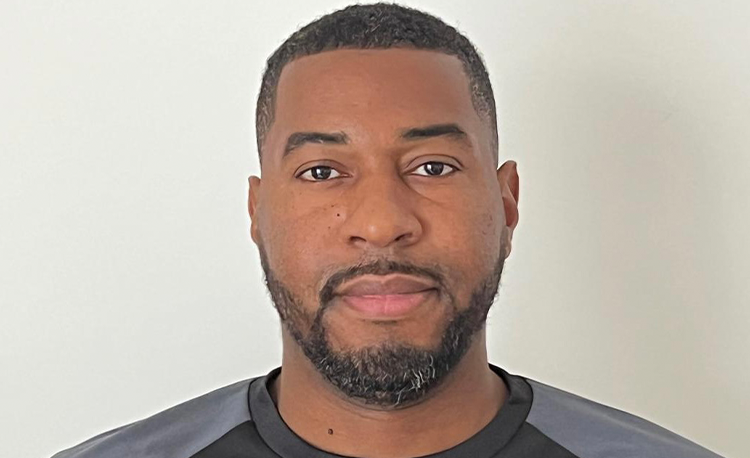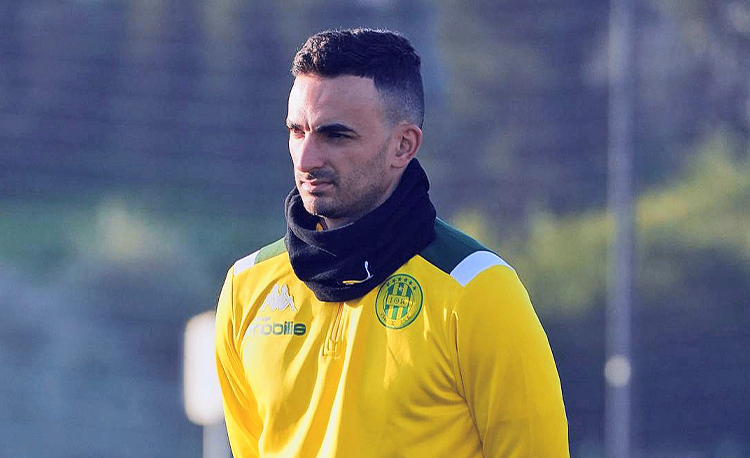This training session is all about creating overloads in tight spaces when in possession. Three is the magic number here and this session encourages players to use the three-player support system to create overloads.
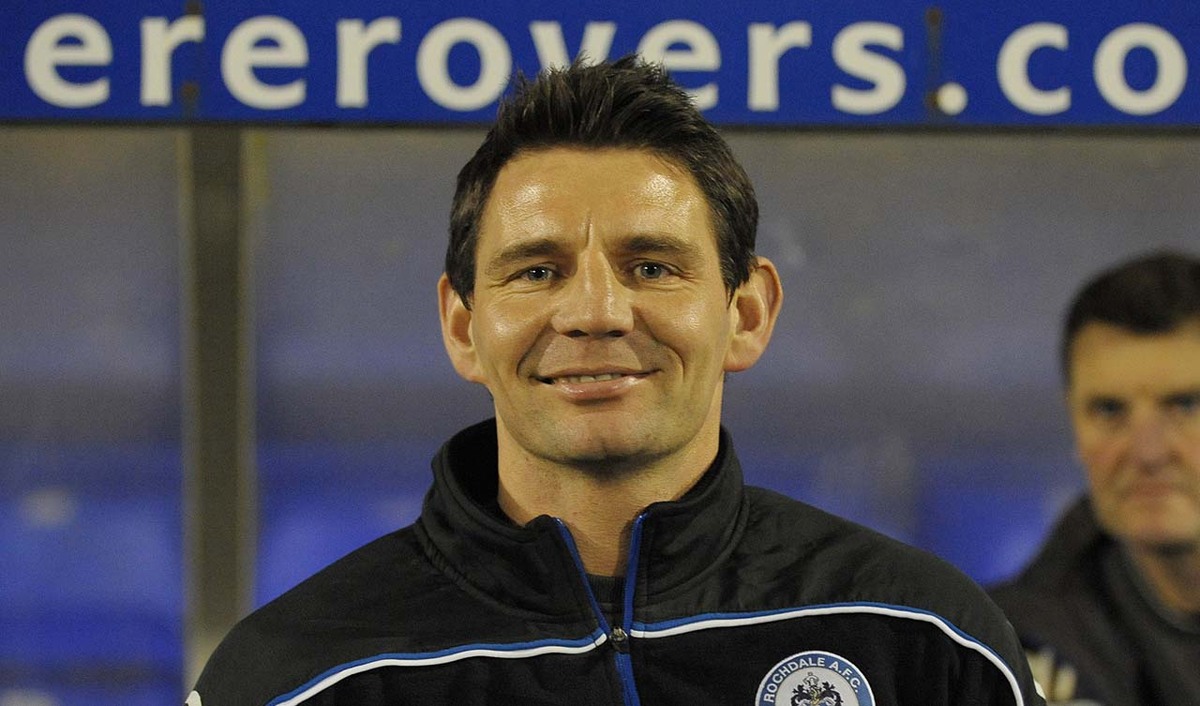
| Area | Up to full pitch |
| Equipment | Balls, bibs, cones, 2 full size goals |
| No. of Players | Up to 20 players + 2 goalkeepers |
| Session Time |
Support in threes: 15mins, 11v11 game: 30mins |
This training session is all about creating overloads in tight spaces when in possession. Three is the magic number here and this session encourages players to use the three-player support system to create overloads.
Players are fully engaged due to the simplicity of trying to support the ball with a minimum of three players and it also helps to improve receiving and releasing skills and will encourage quick play.
The session progresses into a game-related 11v11 practice where players can implement what they have learnt from the opening activity.
We also use the session to encourage an aggressive press when out of possession, again in threes, which also helps to improve the intensity and quality of our play when in possession.
What do I get the players to do?
Support in threes
We set up a grid of 20x20 yards containing four 10x10-yard boxes. We’re using 10 players, split into a blue attacking team of four and a red defending team of four, plus two yellow floaters.
Each box contains one blue attacker and one red defender, who are locked in their boxes. The two yellow floaters move between boxes, supporting the attacker in keeping possession and making it 3v1 in each box when the ball is there.
Play begins with a pass from the coach to a blue attacker. The floaters enter that box and combine with the attacker to help them string at least three passes together before the attacker can pass to a team mate in another box, as shown [1]. The floaters follow the ball into the new box. If a floater is in possession after the completion of the three passes, he can dribble the ball into another box (followed by his team mate) to start a new passing 3v1.
1
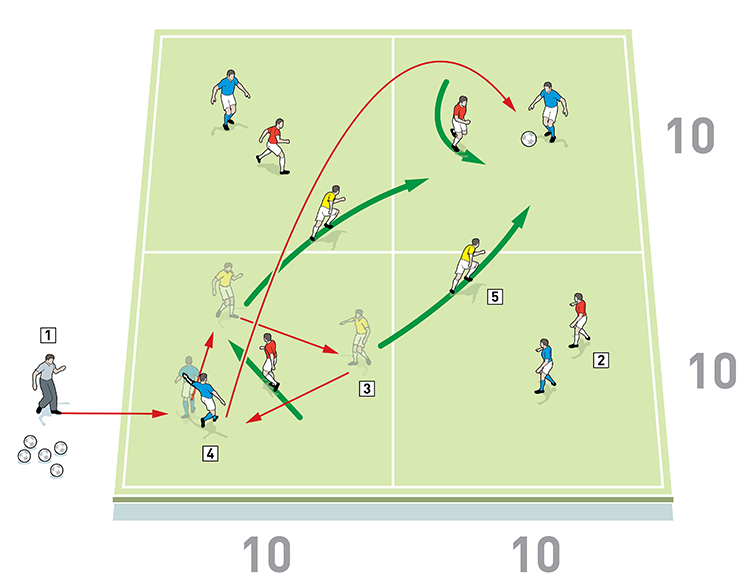
2. Each box contains one red defender and one blue attacker. They are locked into their box
3. The two yellow floaters can move freely and must follow the ball into the box and combine with the attacker to keep possession
4. After stringing three passes together, the attacker can pass to a team mate in another box, as here, or one of the floaters can dribble the ball into a new box
5. The floaters follow the ball into the new box and work to pass with a blue in a new 3v1
The emphasis should be on speed of play, with movement and support both key to the success of the session. The coach should be looking for fast control with support.
We play in five blocks of 90 seconds, rotating players into the floating role every 90 seconds. On completion, we repeat for another five blocks of 90 seconds.
How would you put this into a game situation?
11v11 game
We set up on a full size pitch with a goal and a goalkeeper at each end, but the pitch size can be adjusted depending on our needs. We play a normal 11v11 game based on our own formation and the formation of our next opponents, but the players must be encouraged to work in the three-player support system they used in the first practice.
As an example of this, in the diagram [2a] when the ball is played from the left centre back to the left back, the three players nearest to the ball must move to support. Other players farther away must also move closer, in order to cover the spaces vacated by the supporting players. This also means that they are close enough for link-up play when the ball is moved on again.
2a
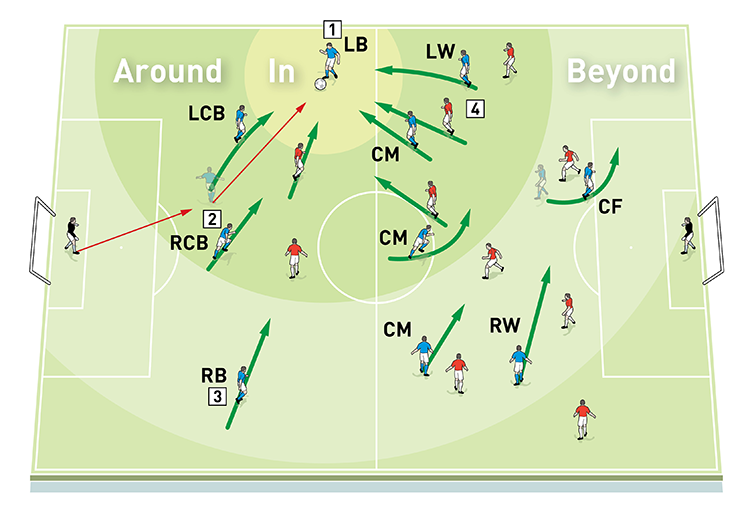
2. Some players also move to cover spaces left by the support play but they should remain position specific. Here the right centre back slides over into the ‘AROUND’ zone to cover the space vacated by the left centre back
3. The right back slides over to cover the space left by the right centre back
4. The team out of possession should be encouraged to press with intensity using the nearest three players to the ball
In the diagram, the proximity to the ball is shown by a series of rings centred on the position of the ball. The ball is received by the left back in the central ring labelled ‘IN’. The nearest players – the left centre back, the centre midfielder and the left winger – move from the ‘AROUND’ ring to the ‘IN’ ring to support the player on the ball.
The support play enables the left back to link up with the left winger, who turns and passes to the centre forward, who has moved to support, as shown [2b]. Now the right winger comes into play, having moved more central to pick up a pass and scores.
2b
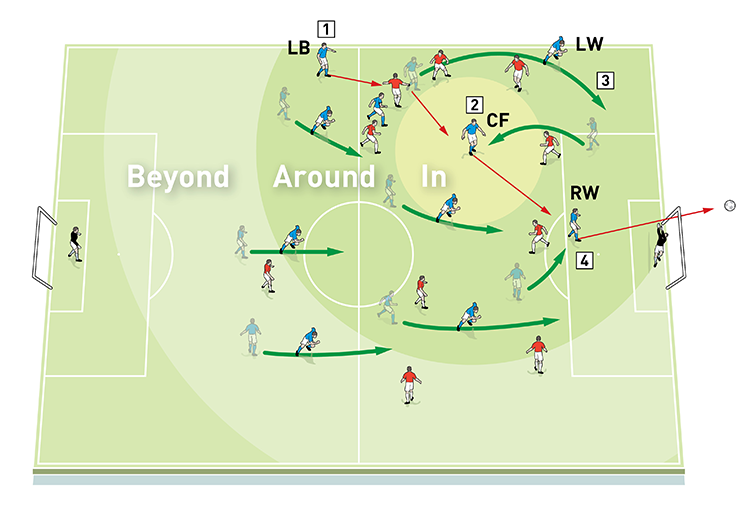
2. The left winger turns and passes to the centre forward who has moved to support
3. Players in the ‘AROUND’ and ‘BEYOND’ zones should be looking to move into areas that support the move, breaking through the lines and finding space to receive the pass
4. The right winger comes into play, having moved more central to pick up a pass and score a goal
The coach is looking for an instant reaction to the pass, with speed of movement and quickness of play critical to creating the space for opportunities on goal.
Players can exaggerate the movement by moving from ‘BEYOND’ to ‘AROUND’ on the pitch but they should stay position specific and not leave gaps. For instance, when the left centre back moves to support the player with the ball, the right centre back moves towards the ‘AROUND’ ring to cover the space.
What are the key things to look out for?
Technically, we want to see players able to use a soft touch, fast passing, a good body shape and the skills to be able to play the ball in tight spaces. Players should also demonstrate a good awareness of what’s around them and try to play forwards whenever possible.
Tactically, we’re looking for players to support the ball with at least three players when in possession and to press with three players near the ball when out of possession.
Most importantly, we want to see quick movement and the ability to react to changing situations.
Editor's Picks
Attacking transitions
Deep runs in the final third
Using the goalkeeper in build-up play
Intensive boxes drill with goals
Penetrating the final third
Creating and finishing
My philosophy
Pressing initiation
Compact team movement
Coaches' Testimonials
Coaches' Testimonials
Join the world's leading coaches and managers and discover for yourself one of the best kept secrets in coaching. No other training tool on the planet is written or read by the calibre of names you’ll find in Elite Soccer.
In a recent survey 92% of subscribers said Elite Soccer makes them more confident, 89% said it makes them a more effective coach and 91% said it makes them more inspired.
Get Monthly Inspiration
All the latest techniques and approaches
Since 2010 Elite Soccer has given subscribers exclusive insight into the training ground practices of the world’s best coaches. Published in partnership with the League Managers Association we have unparalleled access to the leading lights in the English leagues, as well as a host of international managers.
Elite Soccer exclusively features sessions written by the coaches themselves. There are no observed sessions and no sessions “in the style of”, just first-hand advice delivered direct to you from the coach.















